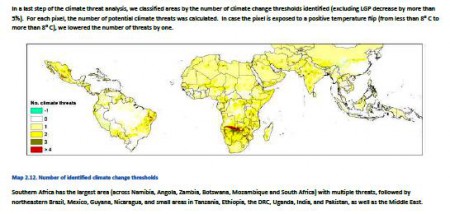- German donor examines food and security, notes “the fast loss of biodiversity”.
- Food carts are successful oases in at least one food “desert”.
- Yesterday’s Botany Photo of the Day was American cotton.
- Good news, everyone: “Hardcore farmers prefer lowkey rituals.” Obviously the memo didn’t reach the children of the corn.
- Photosynthesis and climate change: it’s complicated.
- Native Americans try to reclaim control of their foodways. And their waists.
- “…every district should have a community-controlled seed centre with a gene bank for traditional seeds.” Of course it should. “The local available seed diversity needs to be protected and conserved at any cost.” Of course it must.
- “Right now, all over the world, projects are underway to store seeds…“
- Dark earths not just in Amazon, Africa too.
- Presentation on IFAD project on cultivating wild aromatic etc. species for money in Morocco.
Nibbles: Royal genebank, Fish collection, Plant health, USDA wheat breeding project, Afghanistan, Breadfruit Art, Pests and Diseases, Idaho, Plant breeding, Gates, Panax quinquefolius, Natives
- Thai king has crop genebank on palace grounds.
- Fish in jars.
- Planning Plant Clinics.
- Plant Breeding for Drought Stress: The Project.
- Wait, the Nebraska National Guard has an agribusiness development team? Maybe they should talk to the people responsible for the previous bullet point?
- Kids! (And adults!) An Art Contest to celebrate ‘Ulu. Breadfruit, that is.
- Use of Agrobiodiversity for Pest and Disease Management. A slide show from Carlo Fadda at Bioversity.
- 3rd Annual Biodiversity Working for Farmers Tour in Idaho. 23rd June, you have been warned.
- Huge New York Times story on plant breeding and climate change.
- Bill Gates hails creativity for small farmers challenge.
- American ginseng: use it or lose it.
- Do you live in Ann Arbour? Do you want native plants for your garden? Yeah but how about American ginseng?
Nibbles: ITPGRFA, Hotspots, Adaptation, Agrobiodiversity, Potatoes and climate change, Cowpeas and drought, Apios, Tree planting, Fairtrade, Egyptian archaeobotany, Bolivian video
- All about the International Treaty on PGRFA.
- More, much more, on that climate change hotspots study.
- IDRC on climate change adaptation in Africa. Almost nothing on agricultural diversity as a coping mechanism.
- Unlike this.
- Or this, for that matter. Never knew the Basque country was such a hotbed of potato research.
- Or…oh forget it.
- What, in the name of all that is happy, is hopniss?
- Danone buys some goodwill.
- Fairtrade chocolate: this looks like it should be really important. Is it?
- So, you say you want to know what plant remains were found in the baskets in Tutankhamun’s tomb?
- Bolivian agricultural biodiversity, anyone?
Brainfood: Baby’s veggies, Chickpea and drought, Vine cactus breeding, Paleolithic rabbits, California protected areas, Wild pigeonpea, Pecorino classification, Milk composition, Phenotyping, Wild peas
- Vegetables by Stealth: an exploratory study investigating the introduction of vegetables in the weaning period. Sneaking them into the diet is the most common strategy used by mothers to introduce their kids to vegetables. Reeeeeally?
- Assessment of Iranian chickpea (Cicer arietinum L.) germplasms for drought tolerance. Four out of 150 local landraces showed promise. It really is a numbers game, isn’t it?
- In situ induction of chromosome doubling in vine cacti (Cactaceae). Potentially valuable autopolyploids were produced. Not that it was easy or anything.
- Who brought in the rabbits? Taphonomical analysis of Mousterian and Solutrean leporid accumulations from Gruta Do Caldeirão (Tomar, Portugal). People did, that’s who, but only during the later Upper Paleolithic. Before that it was mainly owls.
- Protected areas in climate space: What will the future bring? Nothing good. Both novel and disappearing climates are over-represented in current protected areas, at least in California.
- Progress in the utilization of Cajanus platycarpus (Benth.) Maesen in pigeonpea improvement. Baby steps.
- Classification of pecorino cheeses using electronic nose combined with artificial neural network and comparison with GC-MS analysis of volatile compounds. Wait, there are different kinds of pecorino?
- The need for country specific composition data on milk. Well, you’ve got me convinced.
- Rate-distortion tradeoff to optimize high-throughput phenotyping systems. Application to X-ray images of seeds. So, let me get this straight, basically, gauging the optimal trade-off between speed and accuracy in high-throughput phenotyping systems depends on what you’re measuring? Who writes these grant applications?
- Experimental growing of wild pea in Israel and its bearing on Near Eastern plant domestication. First pea growers were either very patient or very quick workers.
CIAT and climate change and blogging
“Using blogs and new media to tell the story of climate change and adaptation”, did you say? Let CIAT show you how. On the same day, their multifarious blogs sport a post on the new climate change book on the block, “Crop Adaptation to Climate Change,” from Wiley, to which they have contributed massively. And also a handy summary of the CGIAR Climate Change, Agriculture and Food Security Research Program’s “Mapping hotspots of climate change and food insecurity in the global tropics,” CIAT being the lead centre in CCAFS. There’s also a press release on the hotspots report. However, if the word “hotspots” conjures up visions of the possibility of precisely and reasonably narrowly targeted interventions, beware. In this game, as in many, I suppose, it really does all depend. This below is as good a candidate for the money map as any. But you really do have to read the whole thing, and look at all the maps. And there’s a lot of them. They’ll all be available as Google Earth files soon, right guys?
LATER: And they make it into Time!
